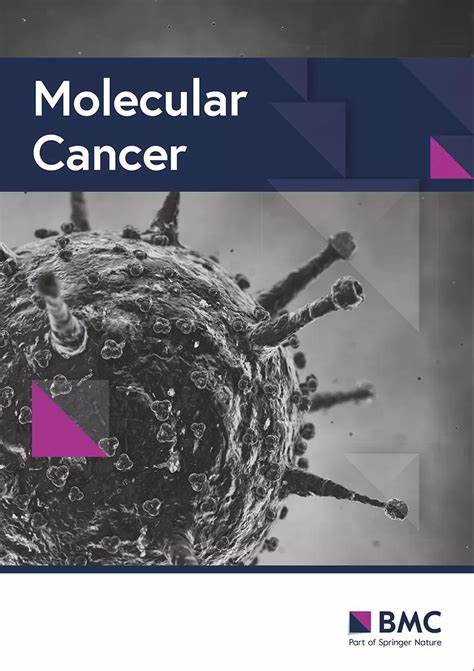从肿瘤前病变到异质肿瘤:肝母细胞瘤生物学和治疗机会的最新见解。
IF 33.9
1区 医学
Q1 BIOCHEMISTRY & MOLECULAR BIOLOGY
引用次数: 0
摘要
肝母细胞瘤是最常见的儿童肝癌,在儿童恶性肿瘤中发病率上升最快。早期的基因组研究表明,肝母细胞瘤是所有人类癌症中突变负担最低的,然而,单细胞RNA-seq、多组学、空间转录组学和功能基因组学筛查的最新进展揭示了其复杂性。不同的细胞亚群、不同的WNT信号、关键的发育途径以及肿瘤细胞和肿瘤免疫微环境(TME)之间复杂的相互作用共同决定了肿瘤的异质性、疾病进展、治疗反应和遗传依赖性。11p15.5染色体嵌合性缺失(LOH)可能是肝母细胞瘤的起始事件,因为11p15.5 LOH克隆扩增发生在邻近的正常肝组织中。胆管细胞样亚群以依赖sox4的旁分泌方式表达FGF19,以驱动邻近胚胎性肝母细胞瘤细胞的增殖。wnt信号依赖性MDK促进免疫抑制性TME,从而损害免疫细胞浸润。TME也可能由红母细胞岛驱动,这影响治疗耐药性。染色质可及性变化驱动的可塑性使肝细胞和肝祖细胞类型之间的分化转变,这与治疗耐药性有关。在这里,我们回顾了儿科肝母细胞瘤细胞、肿瘤相关细胞类型和遗传依赖性的最新发现,这些发现将有助于推进肝母细胞瘤治疗。临床试验号:不适用。本文章由计算机程序翻译,如有差异,请以英文原文为准。
From preneoplastic lesion to heterogenous tumor: recent insights into hepatoblastoma biology and therapeutic opportunities.
Hepatoblastoma is the most common pediatric liver cancer, with the fastest rising incidence among childhood malignancies. Early genomic studies revealed that hepatoblastoma has the lowest mutational burden of any human cancer, however, recent advances in single-cell RNA-seq, multiomics, spatial transcriptomics, and functional genomics screenings have revealed substantial complexity. Diverse cellular subpopulations, divergent WNT signaling, key developmental pathways, and intricate interactions between the tumor cells and tumor immune microenvironment (TME) collectively shape tumor heterogeneity, disease progression, therapeutic responses, and genetic dependencies. Mosaic embryonic loss of heterozygosity (LOH) at chromosome 11p15.5 may be a hepatoblastoma-initiating event, as clonal expansion of 11p15.5 LOH occurs in adjacent normal liver tissue. A cholangiocyte-like subpopulation expresses FGF19, in a SOX4-dependent, paracrine manner, to drive the proliferation of neighboring embryonal hepatoblastoma cells. WNT-signaling dependent MDK promotes the immunosuppressive TME, which impairs immune cell infiltration. The TME may also be driven by islands of erythroblasts, which influence treatment resistance. Plasticity driven by changes in chromatin accessibility enables differentiation transition between hepatocytic and liver progenitor cell types, which is associated with treatment resistance. Here, we review recent findings in pediatric hepatoblastoma cells, tumor-associated cell types, and genetic dependencies that will serve to advance hepatoblastoma therapy. Clinical trial number: Not applicable.
求助全文
通过发布文献求助,成功后即可免费获取论文全文。
去求助
来源期刊

Molecular Cancer
医学-生化与分子生物学
CiteScore
54.90
自引率
2.70%
发文量
224
审稿时长
2 months
期刊介绍:
Molecular Cancer is a platform that encourages the exchange of ideas and discoveries in the field of cancer research, particularly focusing on the molecular aspects. Our goal is to facilitate discussions and provide insights into various areas of cancer and related biomedical science. We welcome articles from basic, translational, and clinical research that contribute to the advancement of understanding, prevention, diagnosis, and treatment of cancer.
The scope of topics covered in Molecular Cancer is diverse and inclusive. These include, but are not limited to, cell and tumor biology, angiogenesis, utilizing animal models, understanding metastasis, exploring cancer antigens and the immune response, investigating cellular signaling and molecular biology, examining epidemiology, genetic and molecular profiling of cancer, identifying molecular targets, studying cancer stem cells, exploring DNA damage and repair mechanisms, analyzing cell cycle regulation, investigating apoptosis, exploring molecular virology, and evaluating vaccine and antibody-based cancer therapies.
Molecular Cancer serves as an important platform for sharing exciting discoveries in cancer-related research. It offers an unparalleled opportunity to communicate information to both specialists and the general public. The online presence of Molecular Cancer enables immediate publication of accepted articles and facilitates the presentation of large datasets and supplementary information. This ensures that new research is efficiently and rapidly disseminated to the scientific community.
 求助内容:
求助内容: 应助结果提醒方式:
应助结果提醒方式:


